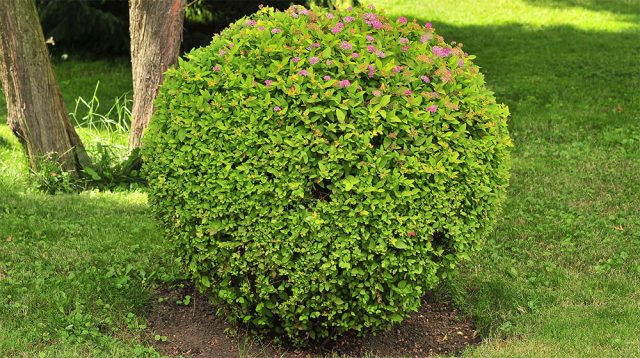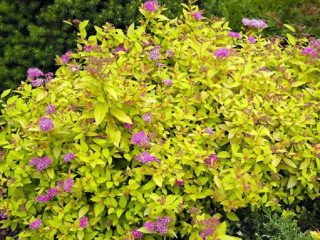Content
Spiraea Goldflame belongs to the ornamental deciduous shrubs. The plant is unpretentious in care, frost-resistant. The beautiful shrub is highly valued by landscape designers. After all, Goldflame spirea, a photo and description of which will be presented in the article, retains its decorative effect throughout the growing season.
Description of spirea Goldflame
Spiraea Goldflame from the Rosaceae family. Found naturally in Japan and China. For Russians this is still an exotic plant.
Bushes
The height of Spirea Goldflame is from 60 to 90 cm. The erect shoots of a red-brown color have a pronounced waxy coating. The shoots grow by 10 cm per year. With proper care and timely pruning, the crown of the spirea is lush and dense. Its diameter is about 1 m.
Leaves
The leaves of the spirea are oval in shape, from 2 to 6 cm long. There are clearly visible notches along the edges of the plates. The colors of the leaf plates are surprising. At the beginning of spring they are bright green, then the color changes to bronze-golden, and in the fall they become brown-bronze.
On one bush you can see all the shades at the same time (this is clearly visible in the photo). The name “Spiraea japonica Goldflame” is translated from Latin as “golden flame”.
Flowers
The buds form in early June, the flowering itself lasts until the end of August. The inflorescences are small, collected in racemes. They are so fragrant that they attract many insects, including bees. That is why beehives are often installed next to Goldflame spirea plantings.
In place of the flowers, by the beginning of September, shiny boxes with seeds form.
Spirea Goldflame in landscape design
Landscape designers have a special relationship with the Japanese spirea Goldflame. The decorative and unpretentiousness of the bushes allows them to be used for decorating flower beds, borders, and creating hedges. After all, the branches are arranged so tightly and densely that nothing can be seen through them.
If group compositions are expected, then the following crops can be planted next to the Japanese spirea Goldflame:
- lilac;
- mock orange;
- primrose;
- lilies of the valley;
- curb flyers;
- lavender;
- Potentilla;
- barberry.
Spiraea looks impressive against the background ground cover perennials with green foliage.
You can plant Japanese spirea Goldflame separately. Thanks to the haircut, bushes of original shapes are obtained. Fragrant flowers of the bush are widely used by florists to create bouquets from a wide variety of compositions.
Planting and caring for Japanese spirea Goldflame
Before planting Japanese spirea, you need to choose the right place. The plant needs sunlight, but it is better to grow bushes in openwork shade. In this case, the leaves will be bright, and the flowering will be lush and abundant.
Spiraea Japanese Goldflame, according to the description, will not like places where there are drafts. It is not recommended to plant plants in areas where groundwater is high or in lowlands, as such proximity can provoke disease of the root system.
For planting, select areas with fertile, loose soil, preferably acidic. Spiraea leaves acquire their brightness precisely on such soils. If the soil lacks nutrients, then humus, peat, and sand are added to the holes before planting.
Caring for Japanese spirea Goldflame is simple and comes down to traditional measures:
- watering and loosening;
- fertilizing and mulching;
- pruning and preparation for winter.
Preparation of planting material and site
In order for the Japanese spirea Goldflame to decorate the site for several years, you need to take care in choosing seedlings. If you don’t have your own planting material, you should buy young plants only from sellers who take their business seriously. But the highest quality seedlings, as a rule, come from nurseries.
Plants should have developed, elastic roots, preferably with a moist lump of earth. Neither the root system nor the shoots should be damaged by diseases or pests.
The area for planting spirea is carefully dug up, not only is it removed weeds, but also all rhizomes. If necessary, fertilize the soil.
Landing rules
Goldflame spirea seedlings can be immediately planted on a border prepared in advance or in holes.
And now about how to properly plant young spirea bushes:
- About 2 weeks before planting, they dig holes to a depth of 40-50 cm.
- The bottom is covered with drainage: broken bricks, pebbles.
- Then fill the hole with a nutritious soil mixture and water it abundantly so that the soil settles.
- A mound is made in the center of the planting site on which the plant is planted.
- Straighten the roots and cover with soil.
- About 4 liters of water at room temperature are poured under the plant.
- The surface is sprinkled with mulch to retain moisture. It can be humus, sawdust, fresh mown grass.
Watering and fertilizing
Goldflame spirea should be watered sparingly, avoiding stagnation of water. Particular attention should be paid to bushes in the summer heat, since even a slight drying out of the top layer of soil negatively affects not only the development of the plant, but also its decorative effect.
It is necessary to ensure access of oxygen to the root system. To do this, each watering is combined with loosening and mulching with peat or compost.
Abundant flowering of Japanese spirea Goldflame is possible only in the presence of fertile soil. Organic or mineral fertilizers are used for feeding. It is enough to add food 3-4 times during the growing season.
Pruning spirea Goldflame
Bushes of exotic plants must be formed by pruning.This procedure begins 4 years after planting.
There are 3 types of spirea haircuts:
- formative;
- rejuvenating;
- sanitary
After wintering, frost-damaged and dry shoots are removed from the bushes. Closer to autumn, cut off the inflorescences. At the same time, the crown of the plant is formed: Japanese spirea Goldflame responds well to pruning and becomes more magnificent. In addition, every gardener can use his imagination and trim the crown, giving the bush the desired shape.
Despite the fact that spirea grows on the site for quite a long time, from time to time it is necessary to carry out a rejuvenating haircut to extend its life. Work should be planned for the spring, until sap flow begins. Almost all shoots are cut out to a height of no more than 1 cm. After some time, young shoots will appear.
Preparing for winter
Adult bushes of Japanese spirea Goldflame can withstand frosts in winter. When it gets very cold, sometimes the branches freeze. But with the help of spring pruning you can restore spirea.
But young plants need to be well covered for 2 years. The event does not present any particular difficulties:
- The soil is thoroughly loosened, a layer of mulch of at least 10-15 cm is poured to insulate the root system.
- Burlap is laid on top, and fallen leaves are placed on top.
- After this, the stems of the bush are bent to the ground, fixed with staples and wrapped in any non-woven material.
- With the onset of stable positive temperatures, the shelter is removed and the staples are removed from the shoots.
Reproduction
To obtain new bushes of Japanese spirea (spiraea japonica goldflame), layering, cuttings, and seeds are used. Events are held at different times. To get high-quality seedlings, you need to root them correctly.
Layerings
Early in the spring, before the foliage blooms on the bushes, a healthy young shoot is lowered to the ground and firmly fixed in a horizontal position with a bracket. The entire shoot is sprinkled with fertile soil. All that remains is to water, not allowing the soil to dry out. By autumn, the root system will form, but the seedling is separated from the mother bush the next year.
Cuttings
To propagate by cuttings, towards the end of June, a high-quality shoot is cut from Goldflame bushes. It is cut into pieces so that each one has at least one living kidney.
For rooting, use a peat-sand mixture in equal proportions. The soil is moistened and the cuttings are inserted with the bottom cut. To ensure successful root development, the future spirea is watered 3-4 times a day. In autumn, cuttings need to be covered in the same way as young plants.
Seed propagation method
Sowing of seeds is carried out in early spring in containers with nutrient soil. Seedlings are planted in the main place at the end of June. When replanting, you need to pinch the roots.
Diseases and pests
The plant is resistant to almost all diseases. But insects attack spirea constantly.
The most dangerous are:
- rose leaf roller;
- spider mite;
- aphid.
The leaf roller appears at the end of spring. She chews leaves. If emergency measures are not taken, the shoots will remain bare. Aphids suck juice from leaves and damage stalks and shoots. To destroy these pests, “Pirimor” is used.
If a cobweb appears on the bush, and holes appear on the foliage and inflorescences, it means that the spirea has been attacked by a spider mite. If the necessary measures are not taken, the leaves will soon dry out and fall off. Spider mites reproduce very quickly in hot, dry weather. To process shrubs you can use:
- "Phosfamide";
- "Acrex";
- "Karbofos".
Conclusion
Spiraea Goldflame is an unpretentious plant for the garden. It is used for landscaping public gardens and city parks. Throughout the growing season, the shrub looks original against any background.


















